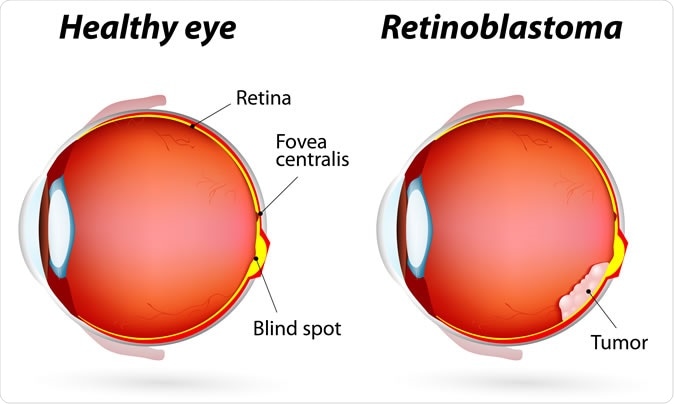A retinoblastoma is a dangerous cancer often occurring in very young children, under 2, which can cause blindness or the loss of the eye. The tumor is a diffuse, gluey mass spread all over the eye. It also spreads easily. As a result of this, direct biopsy is impossible, unlike with most other tumors. Instead, eye examination by ophthalmologists (eye specialists) and ultrasound imaging are needed to make a diagnosis.

Healthy eye and Retinoblastoma. Image Credit: Designua / Shutterstock
Now, a new study published in the journal Ophthalmology says that while a direct biopsy is not possible, characteristic retinoblastoma-associated changes chromosomes can be detected within the cells floating in the aqueous humor of the eye.
The aqueous humor is the clear liquid in the front of the eye, between the cornea and the intraocular lens. When compared with blood, this liquid proved far superior in sensitivity of tumor detection, picking up over 50% of these cancers. Not only does this improve the accuracy of diagnosis but allows the molecular abnormalities of the disease to be characterized and applied to further diagnostic testing and therapeutic development. This approach has enabled the development of successful treatments for some other cancers.
Serendipity - tumor markers in aqueous humor
Genetic abnormalities have been noted in this tumor early on, but they could not be exploited for diagnosis or treatment because they could be picked up only after enucleation (removal of the eye) was done. However, when intraocular chemotherapy came on the scene, with chemotherapy being injected directly into the eyeball to destroy tiny cancer seeds that break off from the main tumor, it made the preliminary removal of a little aqueous humor necessary to reduce the intraocular pressure.
It was while doing this initial aqueous humor removal that researcher and ocular oncologist Jesse Berry got to thinking, what if the fluid contained tumor-derived mutations that could be used in treatment, just as with many other tumors. Sure enough, the fluid did contain measurable amounts of DNA. When this DNA was compared with the tumor DNA the chromosomal abnormalities proved to be identical. Tumor DNA had never before been obtainable except from an enucleated retinoblastoma-containing eye.
This was all the proof they required that aqueous humor sampling was a form of liquid biopsy for retinoblastoma. Formerly, the scientists were only able to adapt therapy to specifically counteract the mutations found in the tumor in one eye, to save the other eye. Now, they face the possibility of doing genetic analysis on the tumor in the intact eye, to plan targeted therapy and possibly avoid removal of the eye.
Berry says, “It's exciting to be doing this work. We're leading this field and it's going to make significant changes for kids affected by this cancer.”
The study
In the current study, the researchers took samples of aqueous humor from 20 children with retinoblastoma. They also took blood samples from all cases. They then carried out whole genome sequencing on the nucleic acid retrieved from both sets of samples.
The results showed that chromosomal changes characteristic of the tumor were found in 11/20 aqueous humor samples, but in none of the blood samples. This shows that aqueous humor liquid biopsy is far superior to blood liquid biopsy in the diagnosis of retinoblastoma.
Advantages of the current approach
Of course, taking a sample of aqueous humor is not a simple or risk-free procedure, compared to a blood sample. However, it is being routinely done to treat children with retinoblastoma, and is therefore not a high-risk or extreme procedure either. Most importantly, the present study establishes the dramatic improvement in cancer detection using aqueous humor compared to blood. In fact, none of the blood samples signaled the presence of the tumor.
Moreover, aqueous humor samples actually have a second advantage. Many children with retinoblastoma have tumors in both eyes. If a blood test were to show that the child had this tumor, the clinician would still not know which eye the abnormal DNA had come from. On the other hand, with aqueous humor samples containing tumor DNA from each eye, it is possible to tell what genetic abnormalities belong to the tumors in each eye.
A third advantage is that the tumor DNA also serves as a biomarker to tell us more about the outlook for that tumor following treatment. By comparing the mutations found in tumors from eyes that have been saved and those from enucleated eyes, the researchers hope they can predict tumor outcomes.
Conclusion
Thus, putting everything together, it is more than likely that this discovery, described by Berry as “serendipity”, could upgrade treatment practices and research work in retinoblastomas. She concludes, “Aqueous humor biopsy has potential to becoming the new standard of care for retinoblastoma. It is our best chance to diagnose and treat these patients on a molecular level.”
Journal reference:
Berry JL, Xu L, Polski A, Jubran R, Kuhn P, Kim JW, Hicks J, Aqueous Humor is Superior to Blood as a Liquid Biopsy for Retinoblastoma, Ophthalmology (2019). https://doi.org/10.1016/j.ophtha.2019.10.026